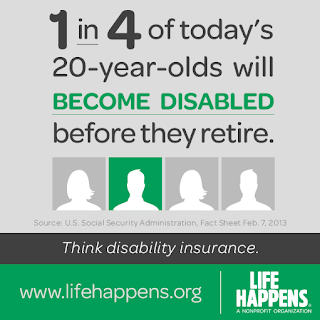What is your most valuable asset?
When this question is posed most people will think of their home or some other tangible asset they own…perhaps their car, boat, recreational vehicle, personal belongings, or even their accumulated savings and investments.
The reality is your income is more than likely your most valuable asset. Your ability to work and earn an income is the primary source of funds to pay for your home, vehicles, and other assets as well as paying for groceries, utilities, and other everyday expenses to maintain your standard of living.
What would happen if you became sick or hurt and were unable to keep working?
Disability insurance is a type of insurance designed to replace your income if you are unable to continue working due to an illness or injury.
You may be surprised to learn 1 in 4 of today’s 20-year-olds will become disabled before they retire.
What resources would protect your income?
- Workers’ Compensation – 90% of long-term disability claims are due to illness and are not work-related, meaning they are not covered by workers’ compensation.
- Savings – Nearly 40% of Americans live paycheck to paycheck. Would your savings be sufficient to cover your expenses for an extended period of time?
- Government – Social Security may not cover all your expenses if you become disabled. At the beginning of 2017, the average monthly SSDI benefit for workers was $1,170 (source: Social Security Administration fact sheet). And, between 2003 and 2012, Social Security disability claim denials averaged 59%.
- Spouse’s Income – Many families rely on two incomes to cover monthly expenses. Could your family get by with just one income?
- Employer-provided Disability Insurance – Group coverage furnished by an employer often has limited benefits and is not available to you after leaving the employer. Also, if your employers pays for the insurance any benefits paid are taxable.
The most flexible and reliable source to protect your income is an individual disability insurance policy you purchase on your own.
- An individual disability insurance policy is portable, meaning you can take it with you from one job to the next.
- Disability insurance is flexible – you can customize a policy to meet your specific needs and budget.
- Individual disability insurance, when purchased with after-tax dollars, provides income-tax free benefits.
There are 3 main components to an individual disability insurance policy:
- Elimination Period – How long, following a disability, you wait before benefits begin being paid.
- Benefit Amount – How much of your income a disability policy would replace.
- Benefit Period – How long benefits would be payable.
Additional options are available that would allow you to increase your coverage in the future regardless of any changes in your health, to have benefits paid increase over time to keep pace with inflation, and to have premiums
refunded if you don’t use your policy.
While the odds of a disability occurring sometime during the course of your career are significant the good news is most people who suffer an illness or injury are eventually able to return to work. This is an important consideration to be aware of as the most common mistake I’ve seen people make when inquiring about disability insurance is narrow their focus solely to purchasing a policy providing ultimate protection – a short elimination period with maximum benefits paid to retirement. While this may be ideal protection, it can come with a price tag higher than the budget permits – those people often decide disability insurance is unaffordable and go without any coverage whatsoever.
A customized disability insurance policy with a modest elimination period, reasonable benefits to make sure your family can pay the mortgage, buy groceries, and pay for utilities, and with benefits payable from 1 to 5 years can provide an excellent financial safety net without breaking your budget.

